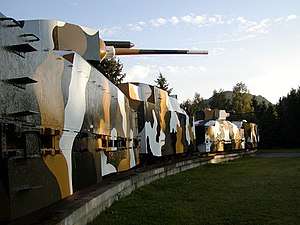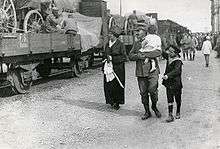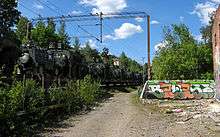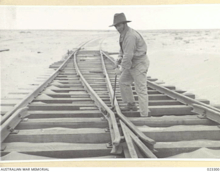Military railways
The military use of railways derives from their ability to move troops or materiel rapidly and, less usually, on their use as a platform for military systems, like very large railroad guns and armoured trains, in their own right. Railways have been employed for military purposes in wartime since the Revolutions of 1848. Improvements in other forms of transport have rendered railways less important to the military since the end of World War II and the Cold War, although they are still employed for the transport of armoured vehicles to and from exercises or the mass transport of vehicles to a theatre of operations. The US Air Force developed the Peacekeeper Rail Garrison mobile ICBM in the 1980's, but it never reached operational status.

Due to the expense and time required to build specifically military railway networks, military use of railways is usually based on a pre-existing civilian railway network rather than a military-owned one. However, specialized military types of rolling stock have frequently been used. Military railway is usually built and operated by railway troops.
Military railways
- British military narrow gauge railways
- Melbourne Military Railway
- Bicester Military Railway
- Fort Eustis Military Railroad
Railways in war



Early Prussian use
The Kingdom of Prussia's VI Corps, some 12,000 men and their guns, horses, ammunition and other material, was transported on two railway lines to Kraków in 1846. The Prussian Army used railways to move its forces during the First Schleswig War in 1849–1851. Three Prussian battalions were deployed by rail to crush the 1849 May Uprising in Dresden. The first Prussian regulations for transport of troops on state railways were issued in 1856.
Hungarian Revolution of 1848
In 1849, an Imperial Russian corps with all of its equipment, was moved by rail from Poland to Göding in Moravia to link up with the Austrian army during the Hungarian Revolution of 1848.
Crimean War
Military railways were used to establish a reliable supply to British Army troops besieging the city of Sevastopol from Balaklava during the severe winter of 1855 in the Crimean War. The Grand Crimean Central Railway was just 7 miles (11 km) long, and was purpose built.
Second Italian War of Independence
During the Second Italian War of Independence in 1859, the French Army moved 130,000 soldiers to northern Italy by rail. The Imperial Guard Corps from Paris and two corps from Lyon were sent to Toulon via rail, from where a total of 70,000 men were shipped to Genoa.[1] The French I Corps was then ferried from Genoa to Novi by rail.[2] Another two French corps were transported by rail to Savoy, where they crossed the Alps and boarded trains to Turin.[3] To improve Piedmont's railway system, the French Navy shipped locomotives to Genoa.[4] A French siege train was shipped from Marseille and Toulon to Genoa, from where it was moved by rail to Lombardy for use against Mantua in late June.[5]
American Civil War
The American Civil War in 1861–1865 was the first large war in which railroads were both a major tool and a major target of military action. A few railroads were custom built:
- United States Military Railroad rebuilt the City Point Railroad, extending to Petersburg during the Siege of Petersburg
- Confederate railroads in the American Civil War
- Centreville Military Railroad
Paraguayan War
In 1867 during the Paraguayan War some ironclad vessels of the Brazilian navy became trapped on the River Paraguay between the enemy Paraguayan forts of Curupaty and Humaitá. To keep them supplied with fuel, ammunition and provisions the Brazilian ministry of marine ordered an emergency military railway to be built through the almost impenetrable coastal region of the Chaco. The sleepers of this line almost floated over the boggy ground. This supply line was known as the Affonso Celso, and sustained the ironclads in their precarious position for six months, until they were able to dash past the Fortress of Humaitá in an incident known as the Passage of Humaitá.
Russian use in Asia
The Trans-Siberian Railway (Транссибирская железнодорожная магистраль - Транссиб), before 1917 was called the Great Siberian Route (Великий Сибирский Путь). First construction begun on 19 May (31 May) 1891. It was used in the Russo-Japanese War and Russian Civil War.
Mahdist War
In 1896-98 during the Mahdist War, Kitchener built the Sudan Military Railroad extending the Egyptian railways into the Sudan.
World War I
Unprecedented heavy use of artillery required transport on an unprecedented scale. Narrow gauge military railways serviced the Western Front, see Trench railways, Decauville (French), Feldbahn and Heeresfeldbahn (German and Austrian) and War Department Light Railways (British).
World War II

German bombing of Polish railways contributed greatly to the swift success of the 1939 invasion of Poland.
Japan built several railways for military purposes, notably the Burma-Siam Railway, known as the Death Railway because of the number of Allied prisoners-of-war and Asian labourers who died to construct it.
The existing Northeast Indian Railways were expanded by the Americans to supply China via the Ledo Road. Railway lines were also constructed by the Allies in the Suez Canal area.
See also
- Strategic railway
- Central Asian Military railway
- Feldbahn
- Heeresfeldbahn - German and Austrian military railways
- Light railway
- Longmoor Military Railway - built by the Royal Engineers to train on railway operations on it. It closed in 1969.
- War Department Light Railways
- Railway troops
External links
- "They're Highballing Now." Popular Science, February 1945, pp. 77–83, article on the landing of thousands of rolling stock across D-Day beaches During World War II and rebuilding of French railways.
Citations
- Schneid 2012, pp. 35–36.
- Schneid 2012, p. 36.
- Schneid 2012, p. 35.
- Schneid 2012, p. 52.
- Schneid 2012, pp. 52, 58.
- "El Kantara, Egypt. 1942-01. A member of the 2nd Railway Construction Company, Royal Australian Engineers". Australian War Memorial. Retrieved 2 September 2019.
Bibliography
- Schneid, Frederick C. (2012). The Second War of Italian Unification 1859–61. Oxford: Osprey. ISBN 978 1 84908 787 2.CS1 maint: ref=harv (link)